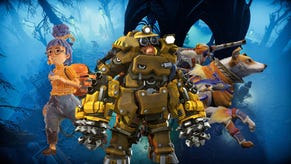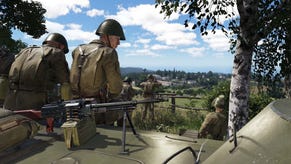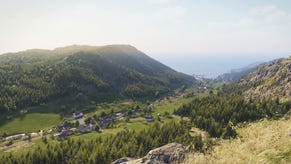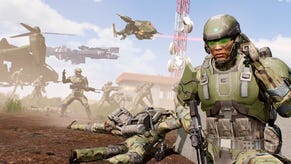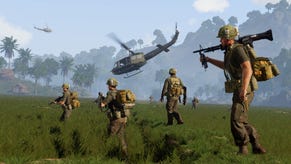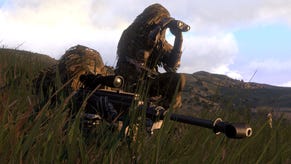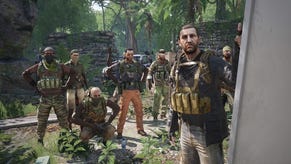Wot I Think: ArmA III
All Greek To Us
Look at that screenshot. Study it. That's not just any ass. That is a rear view of former PC Gamer writer Richard McCormick, and a few days ago I spent at least an hour with this in my face while guiding us around the extensive coast of Altis in an assault boat. It took up so much of my screen for such a long time that I came to see it as not just a digital derriere, but an emblem of ArmA III.
Let's find out why.
The most important, and perhaps the only, important thing about ArmA III is that it is what you make of it. Or, more likely still: it is what others will make of it for you. ArmA is all toolkit. The editor and scripting system which constitute the major part of the game, and give you access to all the AI tanks and soldiers, all the helicopters, drones, and near-future battle gadgets, is a sort of shonky masterwork of instant modding, and will be the forge in which brilliant ideas are, um, forged. As with the previous entries developers Bohemia have built a grand toybox, but done precious little with it themselves – a feeling that may be down, in large part, to a long period of alpha and beta testing of largely the same content. So the elements, the building bricks of ArmA III are one thing. And quite another is the handful of training missions, co-op scenarios, and challenges, with the promise of a campaign to follow.
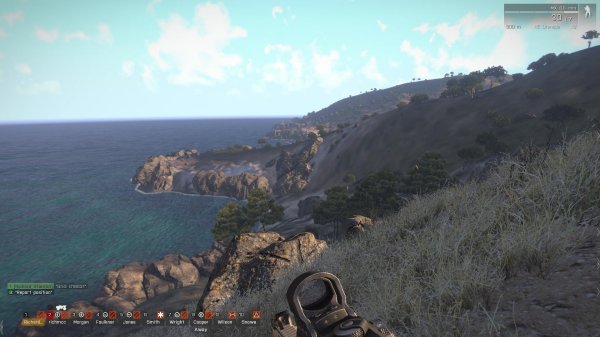
This detail about the campaign doesn't sit well with me. ArmA II came out in March 2009 which means, while admitting Bohemia's attention has been split, ArmA III has had around four years of development, give or take an expansion pack. You could argue that a campaign is largely irrelevant to a toybox and you'd have a point – the Arma II campaign was fascinatingly over-ambitious, but ultimately entertained a diminishing audience. To acknowledge that the campaign is fruitless would also indicate you're an ArmA player already. My perspective is simply do a campaign or don't – but don't launch without one and then boast about the fact it's coming in three 'free' episodes as if this is some kind of revolutionary business model.
What the promise of a campaign to come does is focus your attention on the paucity of Bohemia's own showcases for ArmA III and, much more importantly, how they sometimes fall apart. The in-built missions can suffer from glitches that force a restart, but much more often the problem is with AI squad members and enemies going full moron and screwing things up.
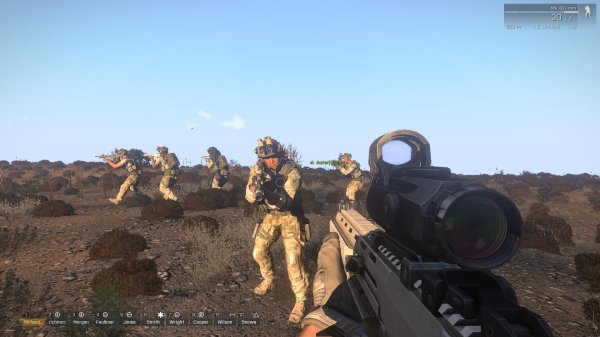
The tale of Arma III's AI going haywire is the tale of why I ended up staring at Richard McCormick's ass for so long.
Here's another picture of it, to set the scene:

Rich and I had been playing a co-op mission slightly haphazardly and, after an explosive time at the airport and lots of headless chicken-ing around the map on quad bikes, our squad was all over the place. Our objective was to escape the island, but after an hour or two the game started doing odd things – the objective would flash up as failed, then start anew. One of our squad just would not move from the airport, so was now something like 6km away while we yelled 'regroup' constantly.
While the AI squad had a picnic, Rich and I reached the port and cleaned out the enemies. We ordered our squad to get into the boats, climbed into one and set off. Out into the deep blue. This is one of the moments that brings home how big ArmA III really is, as you drive the boat forwards for ten or twenty minutes solid but still have a ways to go to the map's edge – and, soon enough, we saw a little island. Rich and I decided to have a look.

We pulled up and got onto the island. Trying to climb up an incline, Rich got trapped in a rock. While he tried to get out I checked the map. Remember those squadmates we'd told to get in the boats? Yeah. Instead they'd chosen to follow us by swimming, and were now either dead or apparently glitching deeper into the water. Rich had been stuck in the rock for minutes now, and somehow his attempts to escape had, like quicksand, pulled his soldier deeper in. Do not stand at my grave and weep, he said, before suiciding with a grenade.
I toddled back over to the boat and Rich respawned a few metres away in the ocean. Our squad was basically screwed. Number 9 was still at the Airfield. So we just sailed for the horizon. I had that view of his behind again – on and on we sailed, with nothing happening, with the objective sporadically failing and resetting. We were well outside the confines of Altis's map, sailing to nowhere while discussing whether we could still complete the mission, whether there was anything out here, and what our idiotic squad were doing.

We eventually decided to drown ourselves. Finally Rich's ass disappeared from my monitor, as in we both went. There were no sharks out here. There was just a featureless and textureless pale blue, with nothing visible in any direction. The edges of the screen gradually darkened, the starkness creeped us out, and then we died. No more ass. But the idea of Rich's ass remained. What it stands for is important.

The thing is that the mission was great fun despite all this, and that counts for a lot – I was pissed off about the AI ruining things, but I didn't feel those hours were wasted time. ArmA III shows clearly in these moments that it's a platform rather than an FPS, and also how profoundly its developers depend on the community; which does mean that this is really about the board and pieces rather than any one game you can play with them.
Given this, you'd expect ArmA III's constituent parts to run and look like a dream. It's a gorgeous game, for sure, with the island of Altis playing the dual roles of bucolic paradise and military fantasy – acres of woodland divided only by trees and the odd dirt path, breaking out into the the cement and steel of military bases and scraps of suburbia. You spend a lot of time in ArmA III humping around the place, and so it's a good thing the sights are this beautiful; it's a game that has you continually tapping the screenshot button.

It is a place that lacks only finesse. Consider the beauty of Altis, next to the fact that many basic animations are considered an unnecessary luxury. Bohemia's focus is in the right place – there are multiple new ways to fine-tune your soldier's posture when aiming and moving, for example. But get into a car and watch how your his android hand lifts, palm-first, and warps him into the seat.
Things like this are in a sense unnecessary, and no doubt there are those who hold some ludicrous notion ArmA is 'purer' this way. But such an overwhelmingly functional approach also bleeds into Altis's interiors. I remember my first mission that involved assaulting the airfield – our squad humped over the map, chatting about what we'd find there. An hour and several dispatched enemy patrols later, we found a huge grey lot with a smattering of choppers, buildings resembling concrete barns, and cavernous hangars that house almost nothing. The same goes for 'normal' buildings like apartments – everything's so sparse and stark, with assets like doors endlessly recycled, that it feels like gunning through limbo.
Still, details such as these are forgivable. Much less satisfactory is Altis's performance online (this is less of an issue with the second, smaller map Stratis) – not necessarily because it's bad, but because what you get often feels random. This has always been an issue with ArmA, and a particular culprit is the framerate being magnetically drawn to 20FPS as you play in larger games.
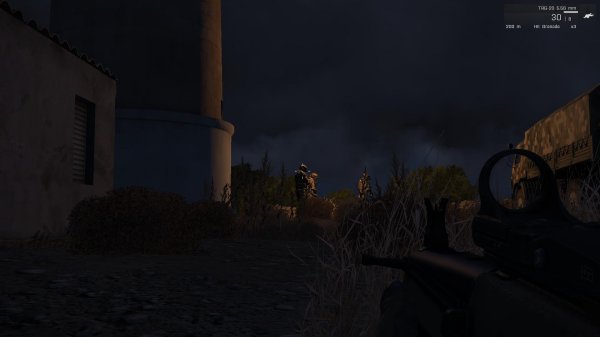
Basically here is the golden rule. ArmA III runs beautifully in singleplayer and small co-op missions, but in multiplayer it's an absolute toss-up whether you'll get 40 FPS or 4. There are obvious things to avoid, like the bizarrely popular Wasteland gametype - which may very well be great, but doesn't so much run as smear across your monitor. And anything on Altis with more than around forty players is hoping for far too much. This environment would give any processor a stiff test, and that's fair enough, but it also feels temperamental with it.
It's only fair to note that these problems are largely a result of ArmA's incredible scope and determination to stay absolutely true to the spirit of simulation – inasmuch as nothing is faked here, there really is a giant island being generated in your PC, with all of its inhabitants being tracked in detail by every one of the others. So while ArmA III should absolutely be in a better state than it is, it does very well as long as you rein in that gigantic scope a little. This is why it's such a difficult thing to capture. What other game would you say that about?
Thanks to an extended alpha and beta phase there are hundreds of pieces of community content already, approximately 50% of which is remakes of Operation Flashpoint missions (I'm kidding – just). I've spent plenty of time playing Domination and Annex missions, which probably qualify as ArmA's standard gametypes and are as great as ever, alongside a lot of stuff that – to put a fine point on it – reminds me awfully of ArmA II. This is no bad thing, of course, but the game does feel like it could have used more new elements in general – it's especially disappointing that there's only one type of boat shared across all factions, for example.

With that said there's already plenty of nutty stuff at the margins – Operation Afterburner has you streaking jets over convoys, an atmospheric Metal Gear Solid mission will have any fanboy grinning, and a recreation of the Navy Seals assault that killed Osama Bin Laden had me wondering what I was doing with my life. Despite the objections of purists who don't want to see the great simulation tied to Valve's teat, the integration of the community content to Steam Workshop is one of ArmA III's best new features, with acquiring missions simply a matter of browsing and subscribing or, in terms of multiplayer gametypes, joining the server and downloading in-game.
Despite the workshop's ease of use it still feels like Bohemia have done themselves a disservice in terms of introducing ArmA to a new audience – the included missions are too conservative and small in number to really show what ArmA can be, or why you should play it. But ArmA III is also a new start for a game that has always, through its community, delivered in the end. There is no doubt in my mind I'll spend an awful lot of hours with ArmA III over its lifespan and have some fantastic times, because I have absolute faith in what people will make of it. I'm utterly certain that the credit for that time spent will lie, in no small part, with people who aren't actually paid to make it. It's a brave way of developing something, but it seems to work.
Only one game has tributes to Hideo Kojima shoulder-to-shoulder with the War on Terror, then backs it up with tank wars and super-serious assassination missions. That's the thing about ArmA III. You'll sit down for a session and four hours later come up, wondering what happened. Did I just stare at my buddy's ass for half an hour, then watch him get sucked into a cliff face? Did I just take out an officer with the perfect sniper shot then escape on a quad bike to a chopper? Was that total bollocks or was it the dog's bollocks?
ArmA III is great. Arma II aside, there's nothing else like it. As time goes on will only get better – but, at launch, it feels a little like moving sideways rather than forwards.
Arma III is available now.
Editor's note:



